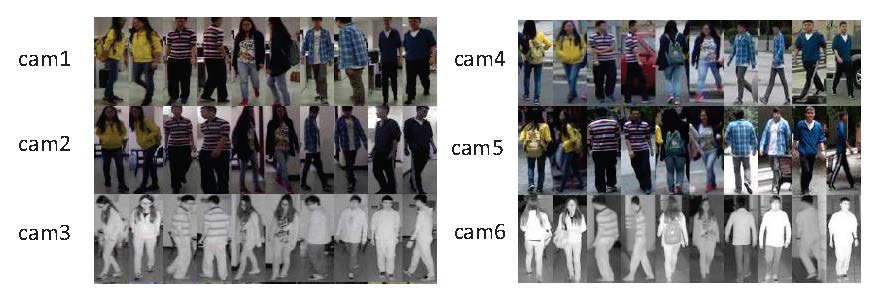RGB-Infrared Cross-Modality Person Re-Identification
Ancong Wu, Wei-Shi Zheng, Hong-Xing Yu, Shaogang Gong, Jianhuang Lai
Sun Yat-sen University, China
Introduction
Person re-identification (Re-ID) is an important problem in video surveillance, aiming to match pedestrian images across camera views. Currently, most works focus on RGB-based Re-ID. However, in some applications, RGB images are not suitable, e.g. in a dark environment or at night. Infrared (IR) imaging becomes necessary in many visual systems. To that end, matching RGB images with infrared images is required, which are heterogeneous with very different visual characteristics. For person Re-ID, this is a very challenging cross-modality problem not studied so far. In this work, we address the RGB-IR cross-modality Re-ID problem and contribute a new dataset called SYSU RGB-IR Re-ID, including RGB and IR images of 491 identities from 6 cameras, giving in total 289,145 RGB images and 16,579 IR images. To explore the RGB-IR Re-ID problem, we evaluate existing popular cross-domain models, including three commonly used neural network structures (one-stream, two-stream and asymmetric FC layer) and analyse the relation between them. We further propose deep zero-padding for training one-stream network towards automatically evolving domain-specific nodes in the network for cross-modality matching. Our experiments show that RGB-IR cross-modality matching is very challenging but still feasible using the proposed model with deep zero-padding giving the best performance.

Figure 1. The RGB-IR Cross-Modality Re-ID Problem.
SYSU-MM01 Dataset
The SYSU-MM01 dataset is an RGB-Infrared (IR) multi-modality pedestrian
dataset for cross-modality person re-identification. It is the first
attempt to address the RGB-IR cross-modality Re-ID problem.
Dataset download:
Please follow the instruction in https://github.com/wuancong/SYSU-MM01/blob/master/README.md
Testing Code
Github: https://github.com/wuancong/SYSU-MM01/blob/master/evaluation
Dataset Description
SYSU-MM01 contains RGB and IR images of 491 identities from 6 cameras including 4 RGB cameras and 2 IR cameras. RGB cameras work in bright scenarios while IR cameras work in dark scenario. There are totally 287,628 RGB images and 15,792 IR images in the dataset.
As for the image capturing details of each camera, RGB images of camera 1 and 2 were captured in two bright indoor rooms (room 1 and 2) by Kinect V1. For each person, there are at least 400 continuous RGB frames with different poses and viewpoints. IR images of camera 3 and camera 6 are captured by IR cameras in the dark. The IR images have only one channel, and they are different from 3-channel RGB images. Camera 3 is placed in room 2 in dark environment, while camera 6 is placed in an outdoor passage with background clutters. Camera 4 and 5 are RGB surveillance cameras placed in two outdoor scenes named "gate" and "garden".

Figure 2. Examples of SYSU-MM01 Re-ID
dataset.

Figure 3. Overview of SYSU-MM01 Re-ID
dataset.
Files Description
Two zip files "SYSU-MM01.zip" and "cam1_2_video.zip" are provided.
"SYSU-MM01.zip" contains data of 6 cameras in directories "cam1" to
"cam6" and data split in "exp".
- "cam1" to "cam6": The name of each directory is ID. Notice that not
every person appears in all 6 cameras.
- "exp": There is a fixed split for training and testing. To get
training, validation and testing IDs, either "txt" or "mat" files can be
used. "available_id" contains 491 valid IDs that appear in at least 2
cameras. "train_id", "val_id" and "test_id" are non-overlap and the
union of them are "available_id".
"cam1_2_video.zip" contains the Kinect RGB videos of camera 1 and 2,
while "cam1" and "cam2" in "SYSU-MM01.zip" are subsampled versions. Data
in directories "cam1_video_train" and "cam2_video_train" of training IDs
can be used for training. Directories "cam1_video_test" and
"cam2_video_test" contain videos of testing IDs, which are currently not
used.
Evaluation Protocol
There are 491 valid IDs in SYSU-MM01 dataset. We have a fixed split
using 296 identities for training, 99 for validation and 96 for testing.
During training, all images of the 296 persons in training set in all
cameras can be applied. Notice that, if validation set is not needed, it
can also be used for training.
In the testing stage, samples from RGB cameras are for gallery set, and
those from IR cameras are for probe set. We design two modes, all-search
mode and indoor-search mode. For all-search mode, RGB cameras 1, 2, 4
and 5 are for gallery set and IR cameras 3 and 6 are for probe set. For
indoor-search mode, RGB cameras 1 and 2 (excluding outdoor cameras 4 and
5) are for gallery set and IR cameras 3 and 6 are for probe set, which
is less challenging.
For both modes, we adopt single-shot and multi-shot settings. For every
identity under each RGB camera, we randomly choose one/ten image(s) of the
identity to form the gallery set for single-shot/multi-shot setting. As
for probe set, all images are used. Given a probe image, matching is
conducted by computing similarities between the probe image and gallery
images. Notice that matching is conducted between cameras in different
locations, that is, camera 2 and camera 3 are in the same location, so
probe images of camera 3 skip the gallery images of camera 2. After
computing similarities, we can get a ranking list according to
descending order of similarities.
For indicating the performance, we use Cumulative Matching
Characteristic (CMC) and mean average precision (mAP). Notice that, for
CMC under multi-shot setting, only the maximum similarity in all gallery
images of the same person is taken to compute the rank list. We repeat
the above evaluation 10 times with random split of gallery and probe set
and compute the average performance finally.
Contact Information
If you have any questions, please feel free to contact wuancong@mail2.sysu.edu.cn.
Citation
Please cite the following paper if you use the dataset in your research:
-
Ancong Wu, Wei-Shi Zheng, Hong-Xing Yu, Shaogang
Gong, Jianhuang Lai, "RGB-Infrared Cross-Modality Person Re-Identification",
In International Conference on Computer Vision (ICCV), 2017. [pdf]
Author homepage: isee-ai.cn/~wuancong.